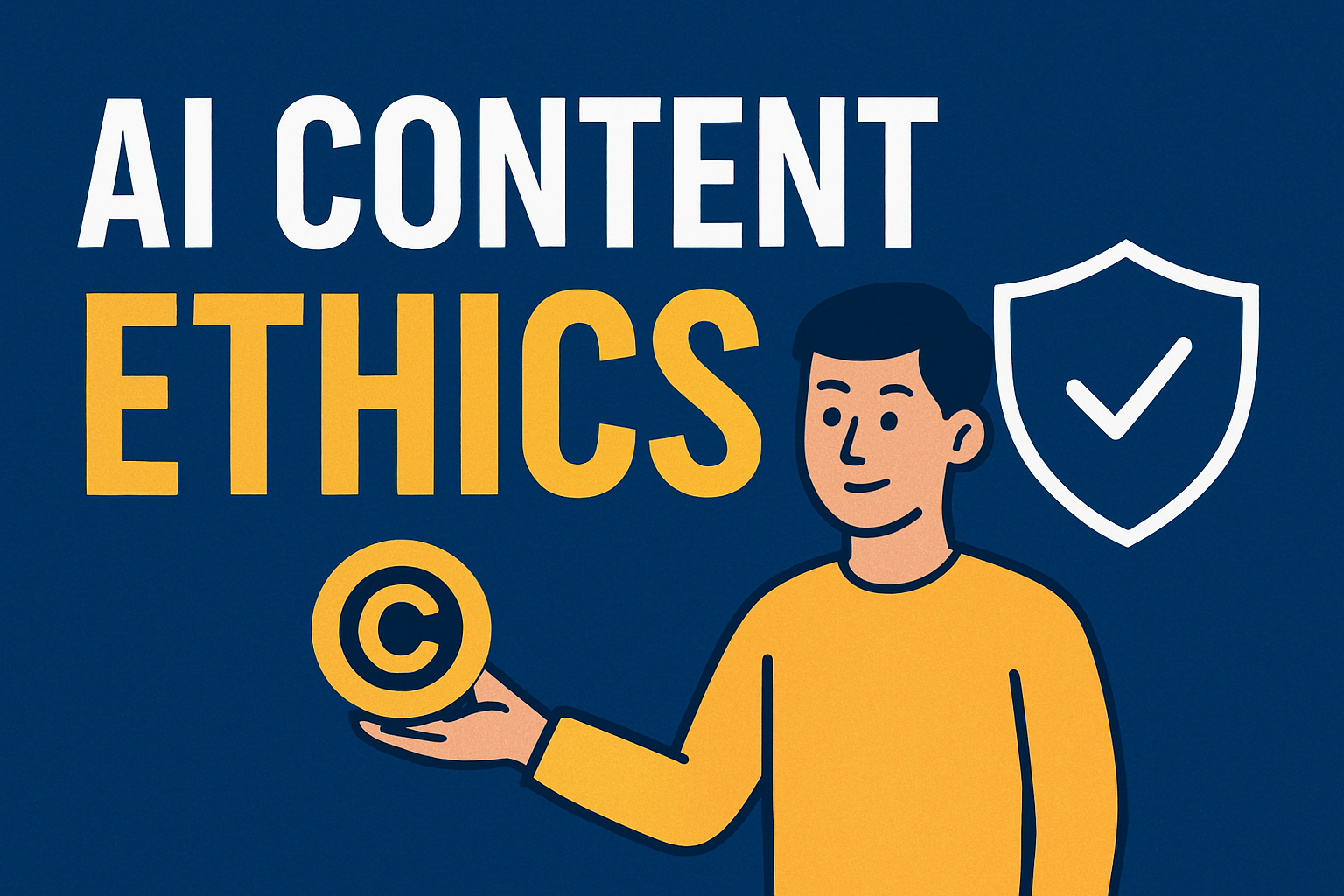
Creating content fast is a headache for many creators today. Did you know over 75% of marketers now rely on AI tools to speed things up? This guide shows how I used AI to create content ten times faster while keeping quality intact.
Stick around, the results might surprise you!
Key Takeaways
- AI tools like Jasper.ai, Copy.ai, and Surfer SEO helped cut content production time by 25% and boosted output by 30% in six months.
- Jennifer’s team saved 62% on costs while doubling engagement on platforms like Instagram and LinkedIn using AI-driven workflows.
- Tools such as Canva, InVideo, and Murf streamlined visual and audio content creation for videos, images, and voiceovers at affordable prices.
- Ethical issues like plagiarism and misinformation require human editing to ensure accuracy, tone consistency, and authenticity in AI-generated content.
- Balancing AI automation with human creativity is key to scaling campaigns effectively without losing quality or brand identity.
Understanding the Challenge: The Need for Faster Content Creation

Jennifer’s team had to deliver 50 pieces of content weekly by 2024. Writing a single blog post, taking about four hours, wasn’t cutting it anymore. The workload kept piling up with long-form articles, videos, podcasts, and personalized emails becoming essential.
The demand created constant stress. Miscommunication and messy workflows added more chaos. Many agencies struggled too; 70% faced tool integration issues while 85% lacked experts for AI system deployment.
Without faster methods or tools like AI chatbots or predictive analytics, dealing with this pressure felt nearly impossible.
Identifying the Right AI Tools
Choosing the right tools can feel like finding a needle in a haystack, but it’s worth the effort. Each AI tool brings something special to boost content creation speed and quality.
Jasper.ai: For blog post writing
Jasper.ai simplifies blog post writing with its 50 pre-designed templates. These templates help content creators write faster and stay consistent. Starting at $39 per month, it’s budget-friendly for individuals and small teams focused on long-form content.
The tool supports integrations like Grammarly, making editing smoother. It improves keyword research and helps create SEO-ready articles. While it’s great for blogs, scaling up large projects could be tricky due to limitations in the platform’s structure.
Jasper.ai remains a powerful AI tool for boosting productivity and enhancing content strategy.
With Jasper.ai, creating quality blogs feels less like a chore and more like a breeze.
Copy.ai: For social media content
Switching gears from blog posts to social media, Copy.ai stands out for marketers needing speed. Its free plan offers 10 credits, allowing businesses to try it without upfront costs.
For growing needs, the small business plan at $49/month fits teams focused on generating a high volume of short-form content quickly.
The dashboard is easy to use and makes creating captions or quick posts simple. It’s perfect for crafting punchy, engaging text while saving time. Though great for short pieces like Tweets or Instagram captions, its tools lack depth for long-form projects.
Unlimited usage requires a custom account setup, which may not suit all budgets.
Surfer SEO: For SEO-optimized articles
Surfer SEO is a powerful tool for improving long-form articles. It offers keyword research, content optimization insights, and real-time SERP trend updates. With plans starting at $19 per month, it suits both beginners and advanced users seeking better search engine performance.
The editing interface simplifies the process with actionable recommendations. Users can tweak content to boost rankings quickly. However, its complex SERP Analyzer and inconsistent keyword suggestions might challenge new users.
Still, marketers rely on it for SEO-focused writing to stay ahead in competitive searches.
Canva: For AI-driven image creation
Crafting SEO-friendly articles is vital, but visuals grab attention fast. Canva simplifies image creation using AI. Its free version works for beginners, while Pro at $12.99/month and Team at $14.99/month fit marketers or businesses on a budget.
The platform generates multiple images per prompt, perfect for saving time in campaigns. While image quality may vary and copyright rules differ by region, its user-friendly design makes content creation accessible to all skill levels.
Teams can streamline projects without breaking the bank, boosting productivity in visual storytelling efforts effortlessly.
InVideo: For video content generation
InVideo speeds up video content creation for digital marketers. It offers thousands of templates and access to Shutterstock assets, making it easy to start quickly. The platform supports various video formats, perfect for different campaigns like ads or social media posts.
Its interface is user-friendly, helping teams with any skill level create polished videos fast.
While a free version exists, watermarks are included unless upgraded. Advanced features may take time to master but can greatly boost productivity once learned. With InVideo, creating marketing content feels seamless and efficient, saving both time and effort in busy workflows.
Synthesia: For avatar-based video creation
Synthesia helps create AI-generated videos using avatars. It supports over 120 languages, making it perfect for global content. Users can personalize avatar videos to fit e-learning and marketing needs.
The tool excels at short-form and multilingual video creation, ideal for training or product demos.
Pricing starts at $30 per month for individuals, with custom plans for larger teams. While high-quality, the personal plan has limits like fewer features and a weak API. Businesses use Synthesia to scale video production while keeping messaging consistent across markets.
Its engaging avatars boost audience interaction in instructional content too.
Murf: For text-to-voice content
Murf bridges the gap between text and high-quality audio. This AI tool turns written content into human-sounding voiceovers with ease. It offers customizable options for tone, speed, and pitch, making it ideal for brand-specific narration.
Marketers use Murf to create explainer videos or podcasts quickly.
Plans start at $19 per month for Basic users; Pro costs $26, and Enterprise is priced at $59 monthly. The platform provides a diverse range of voices but could improve its filters.
While customization is somewhat limited, Murf still excels in delivering professional-grade voiceovers fast. It stands out as a leader in AI-generated content creation for audio needs.
Descript: For audio and video editing
Descript makes audio and video editing quick and easy. It offers overdubbing, transcription, and a user-friendly interface. Podcasters love its tools for fast post-production edits.
The free tier is great for beginners; paid plans start at $12 per month.
The overdubbing feature lets you tweak voiceovers without new recordings. Its transcription tool saves time by converting speech to text instantly. While powerful, it needs high processing power to run smoothly.
Though the timeline options are basic, Descript shines in content repurposing for social media or projects requiring speed.
Building a Streamlined Workflow with AI
Building a smooth routine with AI keeps content organized and fast. These tools act like puzzle pieces fitting perfectly to save time and effort.
Automating content ideation
AI tools like Jasper.ai and Copy.ai accelerate content idea generation in mere seconds. AICONTENTPAD, for instance, assists teams in planning around trending themes or keywords with efficiency.
Content can be customized for various platforms quickly using machine learning algorithms that analyze data for trends.
These tools also enhance creativity. Automated ideation increases the production of concepts without consuming time in lengthy brainstorming sessions. Teams can react quickly to market shifts or viral topics by using AI-driven data analysis and predictions for personalized content creation.
Integrating tools for cross-platform content creation
Streamlining tools like Jasper.ai and Copy.ai boosts content creation for blogs and social media posts. Canva generates AI-powered images, while InVideo helps create videos quickly.
These tools make repurposing seamless across platforms, saving effort and time.
Connecting MatrixLabX with CMS ensures smooth scheduling and publishing. Unified analytics from these integrations provide real-time updates, helping teams optimize campaigns instantly.
This cuts redundancy, keeps branding consistent, and drives better results on all channels.
Benefits of Using AI Tools
AI tools speed up work, plain and simple. They help you create smarter content without breaking the bank.
Time-saving and increased productivity
AI-driven tools cut content creation time by 25%. Jasper.ai can churn out blog posts in minutes. Copy.ai handles social media and CTAs at lightning speed. Surfer SEO ensures articles are optimized without extra effort.
Teams gain more hours for creativity by automating these tasks.
Jennifer’s team boosted their output by 30% after using AI platforms. Workflow automation lets teams focus on storytelling instead of repetitive jobs. Predictive analytics from AI also streamline schedules, ensuring projects run faster with fewer delays.
Cost efficiency and scalability
AI tools slash production costs. Jennifer’s team saw a 62% drop in expenses after adopting them. Hiring writers for a single article can cost $175, but AI tools cut that to just a fraction.
Most come with pricing plans starting at around $30 per month, and annual discounts save even more.
Scalability becomes seamless with these tools. They automate tasks like keyword research and content optimization, so fewer team members are needed. Companies now handle large-scale campaigns over multiple platforms without extra overhead costs.
This makes it possible to produce high-quality content while keeping budgets under control.
Improved SEO performance and content quality
Using Surfer SEO, I tackled keyword research faster than ever. It analyzed data and suggested actionable steps for better content optimization. This meant blogs ranked higher on search engines without endless manual work.
The tool also offered tips for structuring articles, making them both user-friendly and engaging.
AI-driven editing tools polished drafts to maintain a consistent brand voice. They spotted errors and improved readability in seconds. With 87% of marketers already using AI for quality improvement, my process felt future-proof.
Combining these tools with human input boosted the final output’s reliability and appeal while keeping creativity intact.
Addressing Challenges in AI Integration
Making AI tools work seamlessly isn’t always smooth, but cracking these hurdles can lead to better content—read on to see how!
Ensuring creativity and originality
AI-generated content often feels flat and uninspired. It follows patterns but lacks the finesse of human creativity. Machines struggle with cultural nuance or storytelling depth, which are key for strong brand voice and customer experiences.
Human oversight can fix this gap. Guide AI tools like Jasper.ai or Copy.ai by adding personal insights and unique perspectives during edits. Combine machine learning outputs with real-world examples to create standout content.
With teamwork between AI and people, originality thrives in any content strategy.
Maintaining tone consistency across content
Inconsistent tone can confuse readers and break trust. AI tools like Grammarly offer tone detection, but gaps remain. For example, AI struggles to adjust tone for both casual blogs and formal whitepapers.
Missteps in adjusting the writing style can lead to brand dilution or mixed messaging.
Custom AI settings help mimic your established voice better. Still, human editing is crucial to refine content after generation. Without this step, even advanced models may disrupt a brand’s identity or miss industry nuances.
A strong blend of automation and manual polishing ensures consistency across all platforms while protecting audience engagement and loyalty.
Overcoming ethical and authenticity concerns
AI tools can create content fast, but they raise big problems. Misinformation is a risk if AI generates false or misleading details. Misused AI may also copy others’ work, leading to plagiarism.
This damages trust, especially for startups and brands trying to connect with customers.
Machine learning models often lack emotion and context understanding, making the content feel cold or impersonal. Brands must monitor tone consistency to avoid breaking their brand voice.
Relying on human oversight solves many of these issues. By checking facts and edits manually, teams ensure authentic results that build credibility without sacrificing speed or quality.
Ethical Considerations in AI Content Creation
AI-generated content raises serious ethical questions. Plagiarism is a big risk with these tools, as they may copy work from existing sources. This can harm a company’s reputation and lead to legal problems.
Google uses machine learning to find and penalize duplicated or low-quality AI content, which could hurt your search engine rankings.
Misinformation is another issue. AI sometimes creates false or misleading details, especially in complex topics like public health or supply chain optimization. Businesses need safeguards to stop the spread of such inaccuracies.
Human editing must play a key role to check for tone consistency, cultural relevance, and compliance with regional laws. Without this step, companies risk alienating audiences or breaking trust entirely.
Results Achieved: Content Creation 10x Faster
Jennifer’s team cut production time by 25% after adding AIContentPad to their process. This change boosted content output by 30% within just six months. They used Jasper.ai for blog posts, Copy.ai for social media, and Surfer SEO to optimize articles fast.
These tools made content creation simpler without lowering quality.
Costs dropped by 62%, giving the team more room to focus on creative tasks. Engagement doubled on key platforms like Instagram and LinkedIn thanks to better workflows guided by machine learning algorithms.
Companies using similar automation also report a 30% increase in engagement rates globally.
Key Takeaways for Content Managers in 2025
AI tools make content creation faster, smarter, and more efficient. They save time, cut costs, and boost engagement across channels. While they aren’t perfect, they lighten the load for busy teams. Balancing AI with human creativity is key to success. In 2025, embracing AI isn’t just smart; it’s essential for staying ahead.
Conclusion
Creating content faster doesn’t have to be a headache anymore. With smart AI tools, you can boost productivity while saving time and money. These tools turn long hours of work into minutes, handling text, images, videos, and even SEO like pros.
The key? Pick the right tools for your goals, keep quality checks in place, and let creativity shine through. Start small but think big—it’s worth every click!
For a deeper dive into navigating the complexities surrounding the ethical use of AI in content creation, be sure to read our detailed exploration here.
FAQs
1. How did AI tools help speed up content creation in 2025?
AI tools used machine learning algorithms and natural language processing (NLP) to automate tasks like keyword research, content optimization, and creating long-form content. This made workflows faster and more efficient.
2. What role did predictive analytics play in improving the process?
Predictive analytics provided data-driven insights by analyzing real-time trends. It helped refine the content strategy, optimize the content calendar, and improve ROI through better planning.
3. Can AI-generated content still match a brand voice?
Yes, with tools like generative pre-trained transformers and recommendation engines, AI can adapt to your unique tone while maintaining consistency across social media posts or multilingual content.
4. How were large language models used for this case study?
Large language models powered features like web search assistance, speech recognition for voice commands, and generating high-quality ai-generated images that aligned with marketing goals.
5. Is using AI limited to text-based applications only?
No! Beyond writing tasks like blog posts or featured snippets; AI also supports visual needs such as creating ai-generated images or repurposing existing materials into engaging formats.
6. What are some best practices when using AI tools for marketing?
Focus on aligning your goals with specific tools like CRM software or workflow automation systems. Use deep learning models to tailor strategies based on customer behavior while keeping an eye on retention rates and ROI metrics for success tracking!



![AI Tools for Social Media Creators: Instagram, TikTok & LinkedIn [2025]](https://niftynautanki.com/wp-content/uploads/2025/09/AI-009-360x180.png)


![AI Writing Tools Compared: ChatGPT vs Jasper vs Writesonic [2025]](https://niftynautanki.com/wp-content/uploads/2025/09/img-00998-360x180.png)




Comments 1